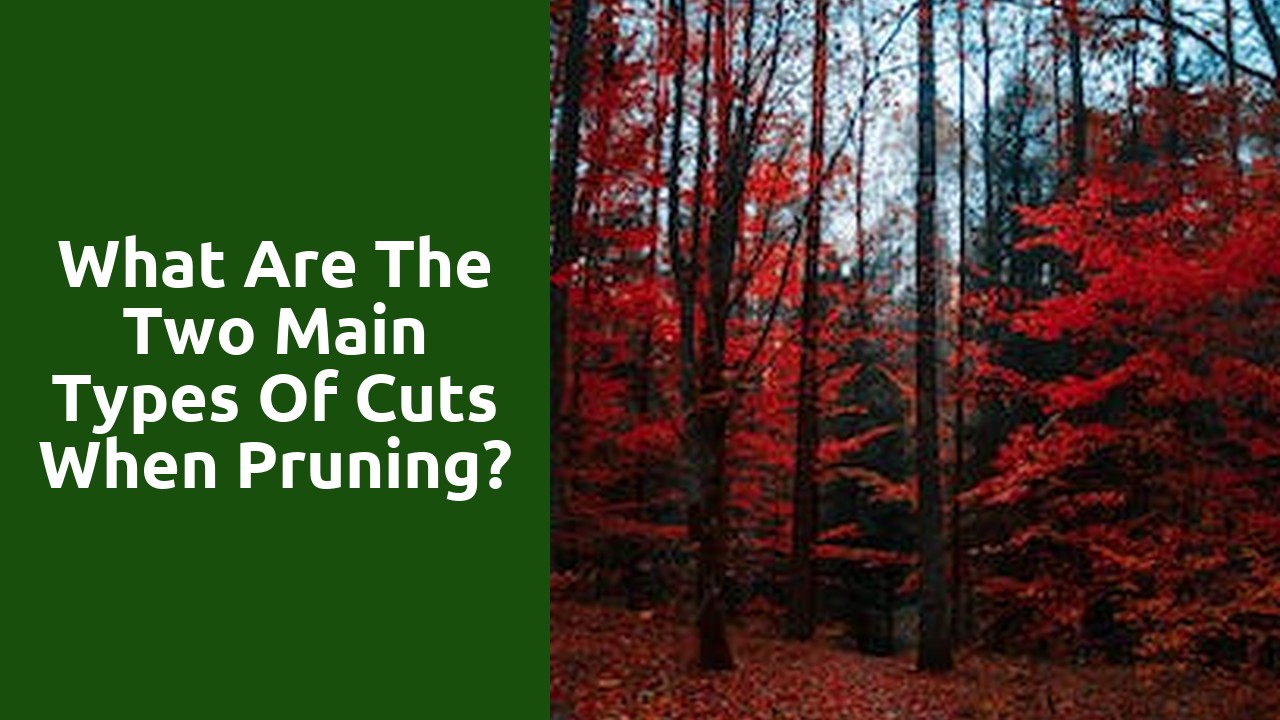What are the two main types of cuts when pruning?

Heading 1: Understanding Pruning Techniques
Pruning is an essential practice for maintaining healthy and aesthetically pleasing plants. It involves the systematic removal of specific parts of a plant, such as branches, buds, or roots. By strategically pruning, gardeners and arborists can achieve a variety of beneficial outcomes, including controlling the size and shape of the plant, stimulating new growth, improving air circulation, and promoting overall plant health.
There are several pruning techniques that can be employed depending on the desired results. One popular method is known as "thinning," which involves selectively removing entire branches or stems to reduce the density of foliage. Thinning allows sunlight to penetrate deeper into the plant, promoting proper growth and preventing the development of diseases. Another technique is "heading back," which involves cutting back the tips of branches to encourage branching and bushier growth. This technique is often used for rejuvenating overgrown plants or shaping hedges. Understanding the various pruning techniques is crucial for achieving desired outcomes and ensuring the long-term health and vitality of plants.
Heading 2: The Purpose of Pruning
Pruning is a fundamental practice in maintaining healthy and aesthetically pleasing plants. The purpose of pruning goes beyond simply trimming off branches or foliage. It is a meticulous technique that involves strategically cutting certain parts of a plant to improve its overall structure, encourage new growth, and optimize its health.
One key purpose of pruning is to remove any dead or diseased branches. These lifeless or infected parts can hinder the overall health of the plant by attracting pests, spreading diseases, or depriving the rest of the plant from receiving sufficient nutrients. By carefully cutting away these areas, the plant can redirect its resources towards healthier portions, promoting stronger growth and reducing the risk of further damage or decay. Pruning also allows for increased air circulation and sunlight penetration, which can contribute to improved photosynthesis and overall vitality of the plant. Additionally, by shaping the plant through strategic pruning, it becomes more aesthetically pleasing and can enhance the overall landscape or garden design.
Heading 2: Promoting Healthy Growth
Promoting healthy growth is essential for individuals of all ages. This includes both physical and mental development, as they are interconnected and equally important. When it comes to physical growth, a balanced diet and regular exercise play a crucial role. Nutrient-rich foods such as fruits, vegetables, whole grains, and lean proteins provide the necessary vitamins and minerals for the body to grow strong and maintain optimal health. Engaging in physical activities such as aerobic exercises, strength training, and flexibility exercises not only helps in maintaining a healthy weight but also strengthens the bones and muscles, improves cardiovascular health, and boosts overall well-being.
In addition to physical growth, promoting mental well-being is equally imperative. Encouraging cognitive development from an early age helps improve memory, concentration, and problem-solving skills. Engaging in activities that stimulate the brain, such as reading, puzzles, and learning new skills, can contribute to the healthy growth of neural connections and enhance cognitive abilities. Moreover, it is important to support emotional growth by fostering positive relationships, building resilience, and teaching effective stress management techniques. By promoting both physical and mental growth, individuals can lead healthier, happier, and more fulfilling lives.
Heading 2: Maintaining Shape and Structure
The preservation of shape and structure is a crucial aspect when it comes to various fields such as engineering, architecture, and even biology. It ensures the stability and functionality of objects and organisms alike. In engineering and architecture, maintaining the shape and structure of buildings and infrastructure is vital for their lifespan and safety. Structural engineers play a key role in designing and overseeing the construction of structures that can withstand external forces and maintain their intended shape without deformations or failures. Additionally, in the realm of biology, maintaining the shape and structure of cells and tissues is fundamental for their proper functioning and overall health.
Heading 2: Heading Cuts
One of the key elements in creating an effective article is having clear and concise headings. And when it comes to heading cuts, it is crucial to understand the importance of a well-crafted heading and how it can impact the overall readability and organization of your content.
When considering heading cuts, it is essential to ensure that they accurately reflect the content that follows. A heading should provide a brief preview of what the reader can expect in the upcoming paragraphs. By carefully selecting and structuring headings, you can make your article more scannable and user-friendly, enabling readers to quickly find the information they are seeking. Additionally, heading cuts can help break up long blocks of text, making your article visually appealing and easier to navigate.
Heading 2: Thinning Cuts
When it comes to maintaining healthy-looking hair, thinning cuts can play a crucial role. This technique involves strategically removing some of the hair's bulk to create a more balanced and textured look. Thinning cuts can be particularly beneficial for individuals with thick or dense hair, as they help to reduce excessive volume and weight. By removing bulk from certain areas, thinning cuts can also enhance the overall shape and movement of the hair.
One of the main advantages of thinning cuts is that they can help prevent hair from appearing too heavy or bulky. This is especially important for people with thick hair, as it can often be challenging to manage and style. By employing thinning cuts, hairdressers can remove excess weight, making the hair more manageable and easier to style. Additionally, thinning cuts can create added texture and dimension, giving the hair a more natural and effortless look.
Related Links
What are the different types of pruning cuts?What is the Y type pruning method?